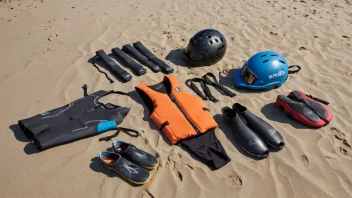In the world of water sports, every detail can make a significant difference in performance, from the technique employed to the equipment used. One of the most critical factors that often goes unnoticed is the weight of the equipment. Whether it’s a surfboard, kayak, or a set of swim fins, the weight of an athlete's gear can heavily influence their speed, agility, and overall performance in the water. This article delves into the nuances of how equipment weight affects athletic performance in various water sports, while providing insights into optimizing gear for better results.
Understanding Equipment Weight in Water Sports
Equipment weight refers to the mass of the gear athletes use during their activities. In water sports, this encompasses a broad range of items including kayaks, surfboards, water skis, wakeboards, and swimming accessories. The weight of these items can significantly influence how athletes perform, as it affects their ability to maneuver efficiently, maintain speed, and conserve energy.
Physics of Weight in Water
Water provides resistance, and the principles of buoyancy and drag come into play when athletes engage in water sports. Heavier equipment can lead to increased drag, making it harder for athletes to move swiftly through the water. On the flip side, lighter gear can facilitate faster movements, allowing for enhanced performance.
Buoyancy Considerations
Buoyancy is the upward force that water exerts on an object, counteracting weight. Lighter equipment generally floats better and requires less energy to keep above water, which is crucial for prolonged activities.
Drag and Resistance
As the weight of the equipment increases, so does the drag force acting against the athlete’s movement. This increased resistance can slow down performance, particularly in competitive scenarios where every fraction of a second counts.
Equipment Categories and Their Weight Implications
Different types of water sports come with varying equipment, each with unique weight considerations that can impact performance.
Cycling (Water Sports Context)
In activities like paddleboarding and kayaking, the weight of the paddle and the vessel itself is paramount. A lightweight kayak allows for easier paddling and quicker acceleration, whereas a heavy kayak can tire an athlete sooner and lead to slower speeds.
Surfing
Surfboards are designed with specific weight distribution to enhance buoyancy and stability. A heavier surfboard can be harder to control but may perform better in certain wave conditions, while a lighter board allows for more agile maneuvers.
Swimming
Swimmers often use specialized suits and fins to enhance performance. The weight of these items can affect buoyancy and drag. Lighter suits can reduce water resistance, while heavier suits may provide warmth in colder waters but can be counterproductive for speed.
Performance Tips for Optimizing Equipment Weight
To maximize performance in water sports, athletes should consider the following tips on optimizing equipment weight:
- Choose the Right Material: Materials like carbon fiber and advanced polymers are lightweight and offer durability.
- Adjust Equipment Size: Ensure equipment size is appropriate for the athlete’s body type and skill level, as too large or too small can affect control and performance.
- Personalize Gear: Tailor equipment to meet personal preferences for weight distribution, which can greatly enhance comfort and efficiency.
Latest Advancements in Equipment Technology
The sports industry has made significant strides in technology aimed at reducing equipment weight while maintaining strength and performance.
Innovative Materials
New materials like lightweight composites, advanced plastics, and even biodegradable materials are being developed. These innovations help athletes perform better while also being more environmentally friendly.
Smart Technology Integration
Some modern water sports gear now comes equipped with smart technology to analyze performance metrics. This data can help athletes understand how weight affects their performance and make informed adjustments.
Case Studies: Real-Life Examples
Examining real-life examples of athletes and teams can provide valuable insights into the importance of equipment weight:
Competitive Kayaking
A professional kayak team recently switched to a new lightweight model that reduced their total weight by 10%. This change led to a noticeable improvement in their speed and maneuverability during competition.
Surfing Championships
In a recent surfing championship, athletes using lighter boards reported higher success rates in waves, proving that equipment weight can be as crucial as skill in achieving victory.
Conclusion
The weight of equipment in water sports is a critical element that directly influences an athlete's performance. Understanding how weight affects buoyancy, drag, and overall maneuverability can help athletes choose the right gear for their specific needs. By optimizing equipment weight through advanced materials and personalized adjustments, athletes can enhance their performance while ensuring safety and comfort in the water. As technology continues to evolve, the future of water sports equipment promises even lighter, stronger options that can propel athletes to new heights.






